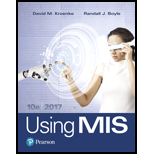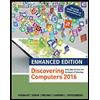
a)
Credit report:
Credit report is a summary of the credit history about lenders and creditors. It has been categorized into four sections they are:
- Personal information of user
- Credit account information like credit card, loans, and mortgages.
- Public record information
- Inquiries
Personal information of user:
This section used to store the user name, contact number, social security number, and employment details.
Credit account information like credit card, loans, and mortgages:
This section contains the information about loans, credit accounts and limits and payment history.
Public record information:
This section used to store the information about the tax, bankruptcies, or court judgment against the user account.
Inquiries:
This section has the business information for overall credit report.
a)
Explanation of Solution
In my credit report, there is no error in both personal information and credit data. The following guidance used to check the credit report for last year.
Guidance to review the credit records:
The user should check the credit report at least once in a year to make sure “no errors” in report and get the information about credit history.
Evaluate the personal identifiable information and debt:
This process used to evaluate all payment history like monthly payments, interest payments, etc. If the personal information wrongly updated on the report, then the user can complain for that.
Check for inaccurate data:
An inaccurate data like mistaken name, mistyped address, or incorrect amount can confuse the user. So, checking for inaccurate data is essential to users.
b)
Credit report:
Credit report is a summary of the credit history about lenders and creditors. It has been categorized into four sections they are:
- Personal information of user
- Credit account information like credit card, loans, and mortgages.
- Public record information
- Inquiries
Personal information of user:
This section used to store the user name, contact number, social security number, and employment details.
Credit account information like credit card, loans, and mortgages:
This section contains the information about loans, credit accounts and limits and payment history.
Public record information:
This section used to store the information about the tax, bankruptcies, or court judgment against the user account.
Inquiries:
This section has the business information for overall credit report.
b)
Explanation of Solution
Actions that are taken by user if they find error in the credit report:
If the user got the error in the credit report, he should take the following actions. They are:
- Inform to the credit bureaus and data furnisher about the error.
- Markup and highlight the mistakes in the credit report
- Request a fresh report from credit bureaus
- Write a dispute letter per error
c)
Credit report:
Credit report is a summary of the credit history about lenders and creditors. It has been categorized into four sections they are:
- Personal information of user
- Credit account information like credit card, loans, and mortgages.
- Public record information
- Inquiries
Personal information of user:
This section used to store the user name, contact number, social security number, and employment details.
Credit account information like credit card, loans, and mortgages:
This section contains the information about loans, credit accounts and limits and payment history.
Public record information:
This section used to store the information about the tax, bankruptcies, or court judgment against the user account.
Inquiries:
This section has the business information for overall credit report.
c)
Explanation of Solution
Identity theft:
- Identity theft is a crime when a hacker access enough information about other person’s identity for financial gain.
- The information can be a signature, name, phone number, or credit card data. Using these personal information, a thief can apply for loan and run up without user knowledge.
Victims of identity theft:
If someone thinks he or she has been the victim of identity theft, he/she should follow some actions to recover his good name and data:
Give the alert on credit file:
After the identity theft, call the credit report agencies and place the fraud alert for the corresponded file.
Request for the credit report and create the identity-theft report:
Request the credit report from credit agencies to calculate theft report. Create the identity-theft report to complain the certain authority.
Contact the authority:
Inform the local law enforcement to take appropriate action for the theft.
Keep the records and originals:
Keep the good notes of all the dealings with creditors and law enforcement. Send the valuable documents as photocopies in certified mail.
Want to see more full solutions like this?
Chapter 10 Solutions
Using MIS (10th Edition)
- Make sure you differentiate between verifying and validating the information. Provide some concrete examples.arrow_forwardHow will you evaluate the information that you retrieve from the library, in computer study , using the evaluation criteria criteriaarrow_forwardPlease answer follow up questions.arrow_forward
- Detailed answer please ( no PLAGIARISM)arrow_forwardBriefly explain your techniques for exam preparation?arrow_forwardFind all the places your personal data is stored. How often and from which databases can you get a hard copy of your informational profile? Why do you feel concerned about the privacy of your information?arrow_forward
 Enhanced Discovering Computers 2017 (Shelly Cashm...Computer ScienceISBN:9781305657458Author:Misty E. Vermaat, Susan L. Sebok, Steven M. Freund, Mark Frydenberg, Jennifer T. CampbellPublisher:Cengage Learning
Enhanced Discovering Computers 2017 (Shelly Cashm...Computer ScienceISBN:9781305657458Author:Misty E. Vermaat, Susan L. Sebok, Steven M. Freund, Mark Frydenberg, Jennifer T. CampbellPublisher:Cengage Learning Fundamentals of Information SystemsComputer ScienceISBN:9781305082168Author:Ralph Stair, George ReynoldsPublisher:Cengage Learning
Fundamentals of Information SystemsComputer ScienceISBN:9781305082168Author:Ralph Stair, George ReynoldsPublisher:Cengage Learning Principles of Information Systems (MindTap Course...Computer ScienceISBN:9781305971776Author:Ralph Stair, George ReynoldsPublisher:Cengage Learning
Principles of Information Systems (MindTap Course...Computer ScienceISBN:9781305971776Author:Ralph Stair, George ReynoldsPublisher:Cengage Learning Principles of Information Systems (MindTap Course...Computer ScienceISBN:9781285867168Author:Ralph Stair, George ReynoldsPublisher:Cengage Learning
Principles of Information Systems (MindTap Course...Computer ScienceISBN:9781285867168Author:Ralph Stair, George ReynoldsPublisher:Cengage Learning Fundamentals of Information SystemsComputer ScienceISBN:9781337097536Author:Ralph Stair, George ReynoldsPublisher:Cengage LearningNp Ms Office 365/Excel 2016 I NtermedComputer ScienceISBN:9781337508841Author:CareyPublisher:Cengage
Fundamentals of Information SystemsComputer ScienceISBN:9781337097536Author:Ralph Stair, George ReynoldsPublisher:Cengage LearningNp Ms Office 365/Excel 2016 I NtermedComputer ScienceISBN:9781337508841Author:CareyPublisher:Cengage





